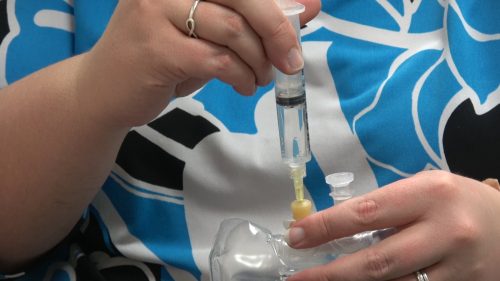Last Updated on December 9, 2021 by Chris and Lindsay
Lindsay has been in Crohn’s Disease remission for nearly ten years. That doesn’t mean her life isn’t impacted because of the illness. In fact, every day brings forth challenges in living with Crohn’s Disease. This is especially true now that she lives on the road full-time.
It just means that Lindsay has been able to avoid the worst of the disease lately. We pray this continues indefinitely. Or, until she is healed of the disease or there comes a cure.
The Value of Crohn’s Disease Remission
Crohn’s Disease impacts each person differently. The first ten years that Lindsay had the disease, before remission, it devastated her. This included physical signs and symptoms ranging from weight loss and vitamin deficiencies to bloody stool and ulcers.
But it also impacted her emotionally. Fear of a flare-up kept her from socializing like a normal teenage girl. What would happen if she was in class, or at a sporting event or friend’s house, and she had to race to the restroom? Would she get permission, or be forced to sit at her desk? Would her friends wonder why she was taking so long in the restroom?
Lindsay likes to joke now about having to use the restroom. But for a while she was ashamed of her disease.
Crohn’s Disease remission has an incalculable value. It means she has time to try and “catch up” on many of the things in which she previously missed. In the past ten years Lindsay put herself through college. First she completed her GED (she never attended a day of high school due to the disease). Then she earned her Associates degree.
Lindsay also engaged in social activities that brought her friendship and pleasure. She learned (and loves) to ballroom to dance. And then she fell in love with horses. She also found a church family that accepted her as she was and helped her emotionally and spiritually through a difficult past. Eventually she met and married her wonderful, sweet and handsome husband (yes, this is him writing this post!).
Now Lindsay is living, against all odds, full-time out of a truck camper as she treks across the North American continent.
There is no value one can place on the quality of life Lindsay enjoys now she is in Crohn’s Disease remission. She is free to pursue the life she wants to live.
The Cost of Crohn’s Disease Remission
But remission also has a cost. That cost includes, but is not limited to, the known challenges of a compromised immune system. It also includes all of the long-term unknowns of treatment Lindsay receives which has proven its effectiveness with time.
Lindsay credits much of her Crohn’s Disease remission status to the medication Remicade (Infliximab). She receives the intravenous treatment of Remicade every 8 weeks with little variation. This treatment, in itself, has a tremendous financial cost. And she’s been fortunate to receive the medication through continuous treatment for almost a decade even though life situations have changed.
Remicade is an intravenous chemotherapy initially developed to fight cancer.
Known Costs of Remission
There are also physical costs that Lindsay pays, albeit gladly in exchange for remaining in remission. Because with Crohn’s Disease her immune system is literally attacking every bad and good cell within her body, Remicade is designed to knock down her immune system for a time. It’s called an immunosuppressant because it weakens her body to defend itself – against bad things, but also against itself.
This means that she is more susceptible to the kinds of illnesses of which most immune systems can defend against. Common colds and viruses can wreak havoc on her immune-compromised body. This leads to her having to take extra steps and precautions against sickness that many people take for granted.
Unknown Costs of Remission
But there is also an unknown impact on Lindsay. The Remicade treatment, like many chemotherapies, is toxic to her body. In exchange for holding Crohn’s Disease at bay, Lindsay admits a cocktail of chemicals into her body which can, at any point, create problems of their own.

Ever watch a commercial for a prescription where the list of side effects seems more complicated than the initial disease? That about sums it up for her.
But because Crohn’s Disease impacts each person differently, there is no one “cure-all” that treats all people equally. Every person must face their disease differently. This means each person living with Crohn’s must decide themselves whether the cost of treatment (known and unknown) is worth the possibility of remission or, God-willing, cure.
Temporary Freedom In Remission
For Lindsay, the benefit of remission outweighs the costs. But she is working toward alternative lifestyle treatments that might help counter the impact of the disease. We’ll share more of those routines and habits shortly. But Lindsay bases a lot of these on the successful healing of Jordan Rubin, author of “The Maker’s Diet.”
Remission is invaluable in the life it provides Lindsay. She is free to dream again, and to pursue those dreams. While she does need to make changes and sacrifices that other people do not have to make in pursuit of their dreams, it is worth it to her to have a semi-normal life.
Lindsay doesn’t feel the status of “remission” excludes her from encouraging other people living with Crohn’s Disease to continue to fight the disease. For her, Remicade has a tremendous positive impact on fighting the disease. For others, Remicade might only cause further complications.
However, Lindsay believes that each day she wakes in remission is another day she can live more fully and inspire others to do the same. She feels fortunate that she is in a time of remission but knows it may not always be this way. For this reason, Lindsay pursues Abundant Life and does not feel she deserves to be treated any differently.
